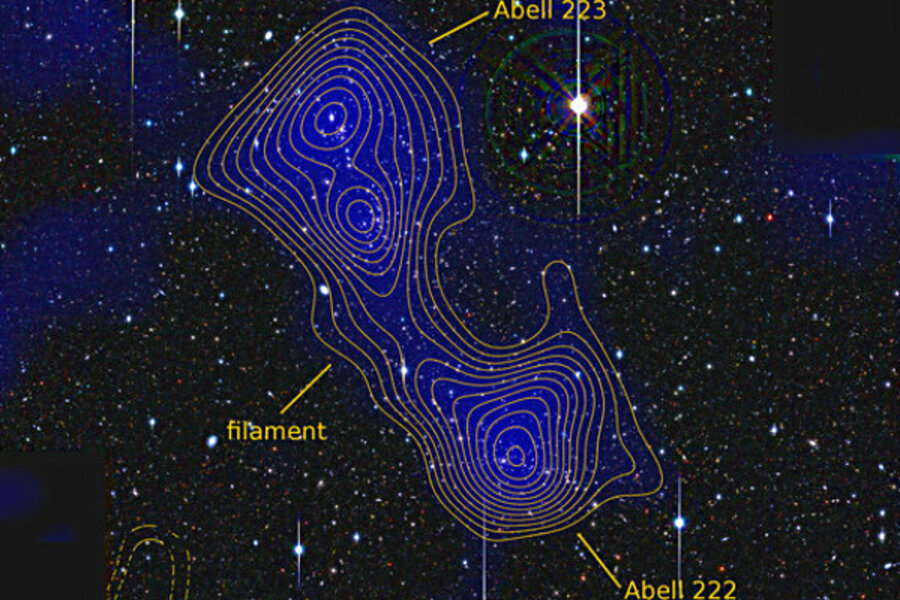Cosmic scaffolding uncovered? Scientists find thread of dark matter.
Loading...
A team of astronomers says it has detected one of the threads of dark matter that scientists have long believed serve as the scaffolding for the cosmos.
Three-dimensional astronomical maps developed since the late 1980s show that the vast majority of the universe's galaxies are distributed as threads and sheets that span the universe, with galaxy clusters as well as superclusters of thousands of galaxies appearing where threads and sheets intersect. These structures were thought to have formed on a framework of dark matter, the unseen form of matter that scientists believe binds galaxies together.
The results announced Thursday mark "the first time we have observationally verified this very important theoretical prediction" of a dark-matter backbone, says Jörg Dietrich, an astronomer at the University of Munich Observatory in Germany who led the team.
The researchers say they expect their discovery to allow them to explore other aspects this underlying cosmic architecture, which could shed light on how the universe is ordered and how it is evolving.
For example, astronomers have found that galaxies at the intersections of the threads tend to be big elliptical galaxies where star formation for the most part has long since ended. By contrast, galaxies along the threads tend to be spiral galaxies, like the Milky Way, and are still forming lots of stars.
In addition, the galaxies along the threads appear to be moving toward the intersections, suggesting that, over time, the threads themselves may vanish, leaving cluster and supercluster "megacities" without any cosmic superhighways connecting them.
Other teams have tried to detect dark-matter threads, but the results either couldn't be confirmed or turned out to be the result of technology limitations.
Indeed, dark matter remains one of the enigmas of the universe. It was first proposed in the early 1930s as a way to explain how galaxies retain their stars. Stars orbit at speeds that by all rights should send them hurtling into intergalactic space. If a galaxy's inventory of matter is limited to what astronomers can see, there isn't enough mass in the galaxy to keep the stars in check.
Astronomers invoked dark matter, suggesting it encases galaxies and provides the gravity needed to serve as a cosmic corral.
But the galaxies researchers observed seemed to be distributed all over the sky, in no apparent pattern.
That notion vanished for good in the late 1980s, when Margaret Geller and John Huchra at the Harvard Smithsonian Center for Astrophysics in Cambridge, Mass., published a three-dimensional map of galaxies. It didn't cover the whole sky, but it showed that galaxies are gathered into thread- and sheet-like structures. The voids between these threads and sheets – anywhere from 36 million to nearly 500 million light-years – could be dotted with a relative handful of galaxies. But the vast majority were distributed along threads and sheets.
Other, more complete 3D maps since then have reinforced the architecture Geller and Huchra identified. A dark-matter scaffold remained the only way researchers could explain the cosmic structure.
Dr. Dietrich's team studied a thread that connects two galaxy clusters, Abel 222 and 223, some 2.4 billion light-years away. X-ray emissions observed by the XMM-Newton X-ray observatory showed that the clusters appeared to be linked by an expanse of hot gas. Additional observations indicated that the clusters were too far apart for their surrounding clouds of hot gas to overlap, suggesting that something else had to be at work.
Further observations at visible wavelengths with Japan's Subaru telescope atop Mauna Kea in Hawaii showed that gravity from something more massive than the individual galaxies between the clusters was bending light and magnifying objects behind it. This phenomenon is known as gravitational lensing and left dark matter as the last explanation standing.
The team estimates the filament's mass at between 65 trillion and 98 trillion times the mass of the sun, with the gas making up about 9 percent of the mass.
What excited Dietrich is how nicely the results appear to match the theory: "We see the dark-matter filament where we see galaxies we expect to live in the filament, and we see emission from hot gas in the filament. We see all the three components we expect in a filament, and in the same location."
The results appear in the July 5 issue of the journal Nature.







